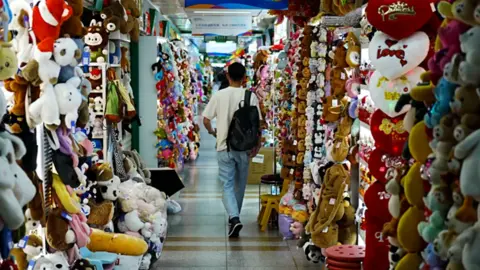The country is finally talking about it, but why now?

Chinese correspondent
The United States – China’s trade war may relax, with two of the world’s largest economies starting to negotiate in Switzerland.
Senior trade officials from both sides met at their first high-level meeting on Saturday since U.S. President Donald Trump reached tariffs on tariffs in January.
Beijing immediately retaliated, and the stalemate followed as the two countries collected taxes on each other. The new tariffs on China’s imports are 145%, and some U.S. exports to China face 125%.
There were weeks of stern, sometimes fiery remarks, both sides tried to portray each other as more desperate parties.
However, they face each other at the negotiating table this weekend.
Then why now?
Saved face
Despite the multiple tit tariffs used for Tat, both sides have been signaling that they want to break the deadlock. Except that it’s unclear who will blink first.
“Neither side wants to back off,” said Stephen Olson, a senior visitor to the Iseas-Yusof Ishak Institute in Singapore.
“The negotiations are going on now because both countries think they can move forward without seemingly falling to the other end.”
Nevertheless, Chinese Foreign Ministry spokesman Lin Jian stressed on Wednesday that “talks will be held in response to the demands of the United States.”
The Commerce Department has helped Washington, saying it is answering “the appeals of American businesses and consumers.”
However, the Trump administration claims that Chinese officials “want to do a lot of business” because “their economy is collapsing.”
“Did they say we initiated it? Well, I think they should go back and study the documents,” Trump said at the White House on Wednesday.
 Getty Images
Getty ImagesBut as negotiations approached, the president made a more diplomatic claim: “We can all play games. Whoever made the first call, who didn’t do it – it’s OK,” he told reporters on Thursday. “It’s just what happens to that room.”
Time scheduling is also the key to Beijing, because this is Xi Jinping’s visit to Moscow. He was a guest of honor at the Victory Day parade in Moscow on Friday to mark the 80th anniversary of the defeat of Nazi Germany in World War II.
Xi Jinping stands with leaders from the global south – reminding the Trump administration that China not only has other trade options, but also regards itself as an alternative global leader.
This allows Beijing to project power as well, even if it heads to the negotiation table.
The pressure is under
Trump insists that tariffs will make the United States stronger, and Beijing vows to “fight until the end” – but the fact is that the levy has hurt both countries.
According to government data, China’s factory output has taken a hit. Manufacturing activity fell to its lowest level since December 2023 in April. This week, a survey by Caixin, a news outlet, showed that service activity has reached a seven-month low.
The BBC found that Chinese exporters have been withdrawing from steep tariffs, even as warehouses piled up in warehouses, even if they caused provocative notes and looked for markets outside the United States.
“I think [China] Realize that a transaction is better than not.
“So they’ve said pragmatically: ‘Okay, we need to have these conversations.'”
So with China’s main Mayday holiday, Beijing officials think it’s time to talk.
On the other hand, uncertainty arising from tariffs led to the first signing of the United States in three years.
The industry that has long relied on Chinese goods is particularly worried. A Los Angeles Toys boss told the BBC they are “looking at the overall implosion of the supply chain.”
 BBC/xiqing Wang
BBC/xiqing WangTrump himself has admitted that American consumers will feel sting.
He said at a cabinet meeting this month that children in the United States may have “two dolls, not 30 dolls,” and that “maybe the cost of these two dolls is a few dollars more than normal.”
Trump’s approval rating has also slipped over fears of inflation and a possible recession, with more than 60% of Americans saying he focuses on tariffs.
“Both countries feel pressure to provide some reassurance for increasingly tense markets, businesses and domestic constituencies,” Olson said.
“The few days of meetings in Geneva will achieve this.”
What will happen next?
Despite the optimism of the negotiations, it may take some time for the agreement to come true.
Mr Hoffman said the negotiations were mainly about “touch foundations” [will be] Setting future negotiations”.
Overall, negotiations are expected to take several months, just like Trump’s first term.
After nearly two years of Tit-Tat tariffs, the United States and China signed a “phase one” deal in early 2020 to suspend or reduce some taxes. Even then, it does not include tricky issues, such as the timeline for the Chinese government to subsidize key industries or the elimination of remaining tariffs.
In fact, many of them remained in place through Joe Biden’s presidency, with Trump’s latest tariffs increasing those older taxes.
What could be happening this time is “the first phase of steroid trading”: that is, it will surpass early trading and try to solve the flash point. From the illegal fentanyl trade, Washington hopes China can work harder toward Beijing’s relationship with Moscow.
Experts warned, but it all fell far away.
“The systemic frictions in the U.S.-China trade relations will not be resolved anytime soon,” Olson added.
“Geneva will only produce anal statements about ‘Frank dialogue’ and the desire to continue speaking.”





